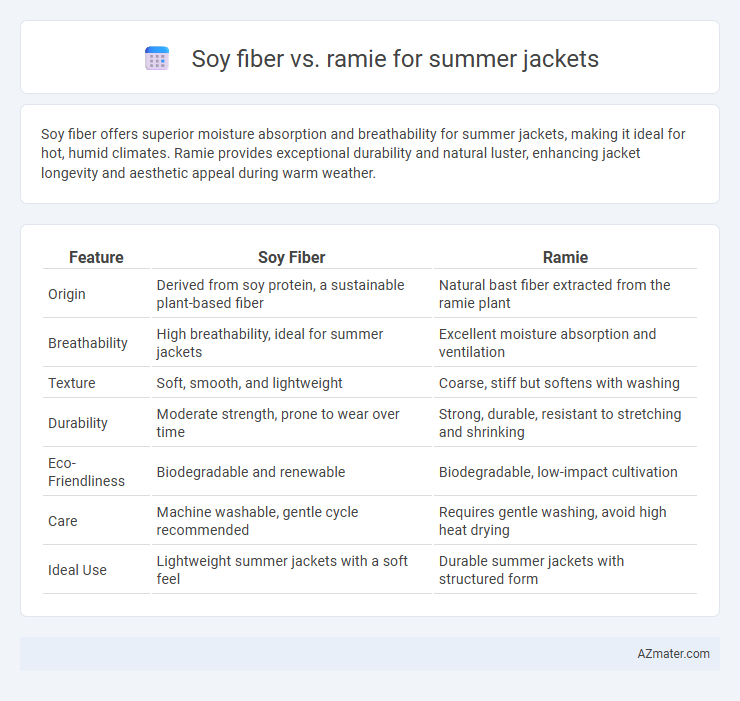Soy fiber offers superior moisture absorption and breathability for summer jackets, making it ideal for hot, humid climates. Ramie provides exceptional durability and natural luster, enhancing jacket longevity and aesthetic appeal during warm weather.
Table of Comparison
| Feature | Soy Fiber | Ramie |
|---|---|---|
| Origin | Derived from soy protein, a sustainable plant-based fiber | Natural bast fiber extracted from the ramie plant |
| Breathability | High breathability, ideal for summer jackets | Excellent moisture absorption and ventilation |
| Texture | Soft, smooth, and lightweight | Coarse, stiff but softens with washing |
| Durability | Moderate strength, prone to wear over time | Strong, durable, resistant to stretching and shrinking |
| Eco-Friendliness | Biodegradable and renewable | Biodegradable, low-impact cultivation |
| Care | Machine washable, gentle cycle recommended | Requires gentle washing, avoid high heat drying |
| Ideal Use | Lightweight summer jackets with a soft feel | Durable summer jackets with structured form |
Introduction: The Rise of Plant-Based Fibers in Summer Fashion
Soy fiber and ramie have emerged as leading plant-based materials in summer jacket production, offering natural breathability and moisture-wicking properties essential for warm weather. Soy fiber, derived from soy protein, provides a soft, silk-like texture with excellent insulation and biodegradability, while ramie, made from nettle family plants, delivers high strength, durability, and a crisp, linen-like appearance. Both fibers support sustainable fashion trends by reducing reliance on synthetic fabrics and enhancing comfort and environmental impact in summer apparel.
Overview of Soy Fiber: Origin and Key Properties
Soy fiber, derived from soy protein extracted from soybean residue, is a sustainable and biodegradable material known for its softness and smooth texture. Its excellent moisture absorption and breathability make it ideal for summer jackets, providing comfort in warm weather. Soy fiber also offers natural antibacterial properties and UV resistance, enhancing the functionality of summer outerwear.
What is Ramie? Characteristics and Historical Uses
Ramie is a natural fiber derived from the stalks of the Boehmeria plant, known for its strength, durability, and lustrous appearance, making it suitable for breathable summer jackets. Characterized by high moisture absorption, resistance to bacteria, and excellent shape retention, ramie provides a cool and comfortable wear in hot weather. Historically, ramie fiber has been used in Asia for centuries in textiles and clothing, valued for its ability to blend well with cotton and silk, offering both aesthetic appeal and functional benefits.
Breathability and Moisture Management: Soy Fiber vs Ramie
Soy fiber offers excellent breathability and moisture-wicking properties, making it ideal for summer jackets that keep the wearer cool and dry. Ramie, derived from a natural plant fiber, provides strong air permeability but has less effective moisture management compared to soy fiber. Choosing soy fiber enhances comfort through superior sweat absorption and quick drying, while ramie contributes durability and natural cooling airflow.
Comfort and Texture: Comparing Feel on the Skin
Soy fiber offers a soft, smooth texture with excellent moisture-wicking properties, making it breathable and comfortable for summer jackets. Ramie provides a slightly coarser feel but is highly durable and offers good breathability, maintaining a fresh sensation on the skin. Both fibers excel in comfort, but soy fiber is often preferred for its silk-like softness and lightweight feel during hot weather.
Durability and Longevity in Summer Wear
Soy fiber, known for its smooth texture and breathability, offers moderate durability but may degrade faster with frequent exposure to summer sweat and UV rays. Ramie, a bast fiber, provides superior strength and resistance to microbial decay, making it highly durable and long-lasting for summer jackets exposed to heat and moisture. Choosing ramie ensures enhanced longevity and wear retention under intense summer conditions compared to soy fiber.
Eco-Friendliness and Sustainability Aspects
Soy fiber, derived from soybean processing byproducts, offers exceptional biodegradability and renewable sourcing, making it a highly eco-friendly option for summer jackets. Ramie, a natural fiber from the stalks of the Ramie plant, boasts strong durability and minimal pesticide use, but its conventional processing can involve chemical treatments that impact sustainability. Choosing soy fiber for summer jackets supports lower environmental impact due to its renewable extraction and reduced chemical reliance compared to ramie's processing practices.
Style and Aesthetic: Visual Appeal in Summer Jackets
Soy fiber offers a soft, smooth texture with a slight sheen, creating a sleek and modern look ideal for summer jackets that emphasize minimalist style and breathable comfort. Ramie presents a natural luster with a subtly rough surface, adding rustic charm and a vintage aesthetic perfect for relaxed, eco-friendly summer outerwear. Both fibers enhance visual appeal by providing distinct textures and finishes that cater to different style preferences in lightweight, breathable jackets.
Care and Maintenance: Easy to Wash and Wear?
Soy fiber offers excellent moisture absorption and breathability, making it easy to wash and quick to dry, ideal for summer jackets requiring low-maintenance care. Ramie, known for its strength and resistance to mold, handles frequent washing well but tends to wrinkle easily, necessitating careful ironing to maintain appearance. Both fibers are durable, but soy fiber requires less intensive upkeep, enhancing convenience for everyday summer wear.
Conclusion: Choosing the Best Fiber for Your Summer Jacket
Soy fiber offers exceptional breathability, moisture-wicking properties, and a soft, silky texture ideal for lightweight summer jackets, while ramie provides superior strength, durability, and natural resistance to mold and mildew, making it perfect for long-lasting outerwear. Selecting between soy fiber and ramie depends on whether you prioritize comfort and softness or durability and resilience in your summer jacket. For a blend of comfort and longevity, combining soy fiber with ramie can offer an optimized fabric solution suitable for warm-weather wear.

Infographic: Soy fiber vs Ramie for Summer jacket
 azmater.com
azmater.com